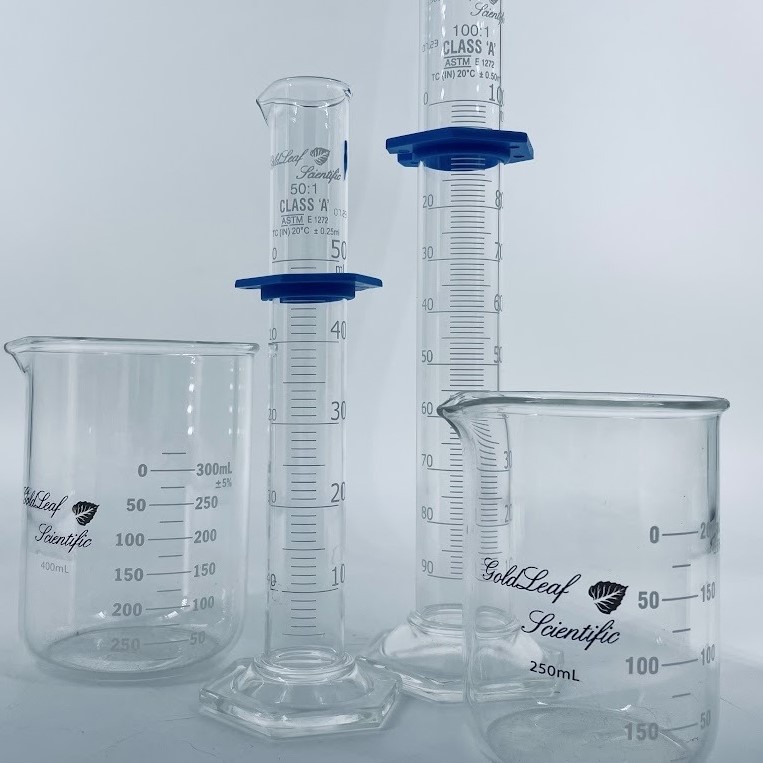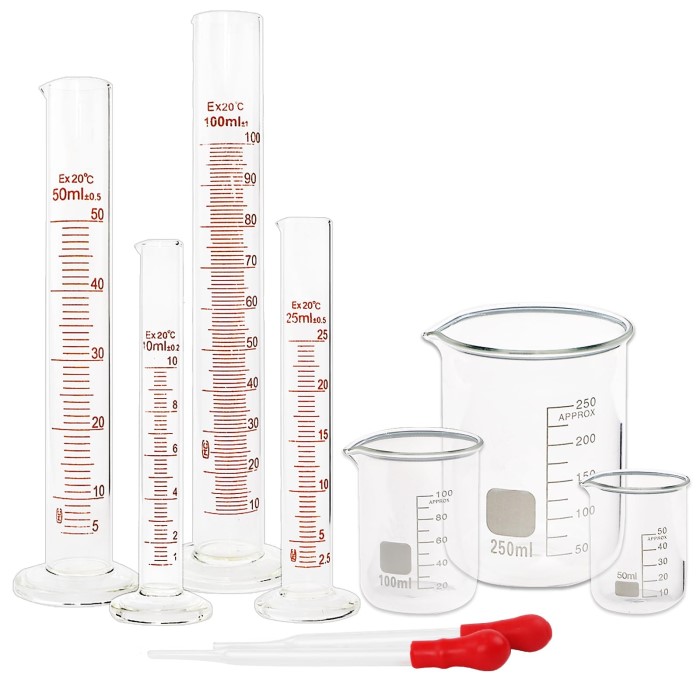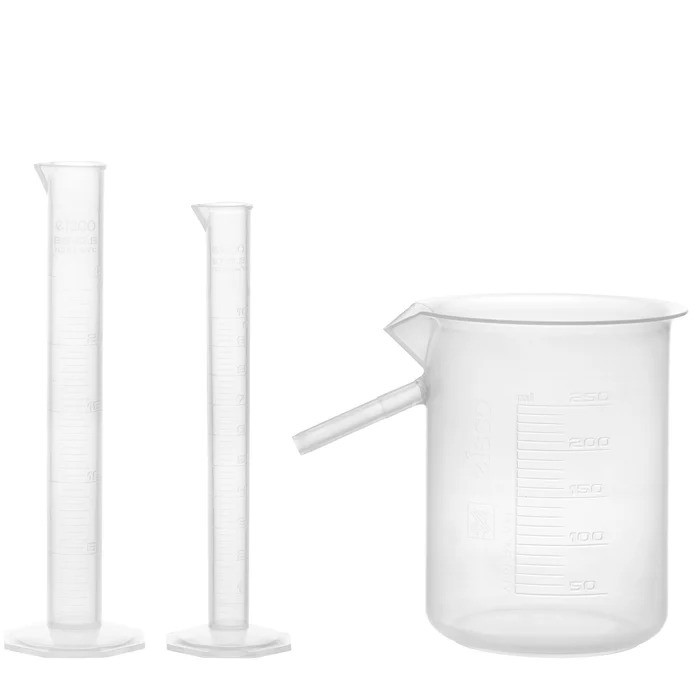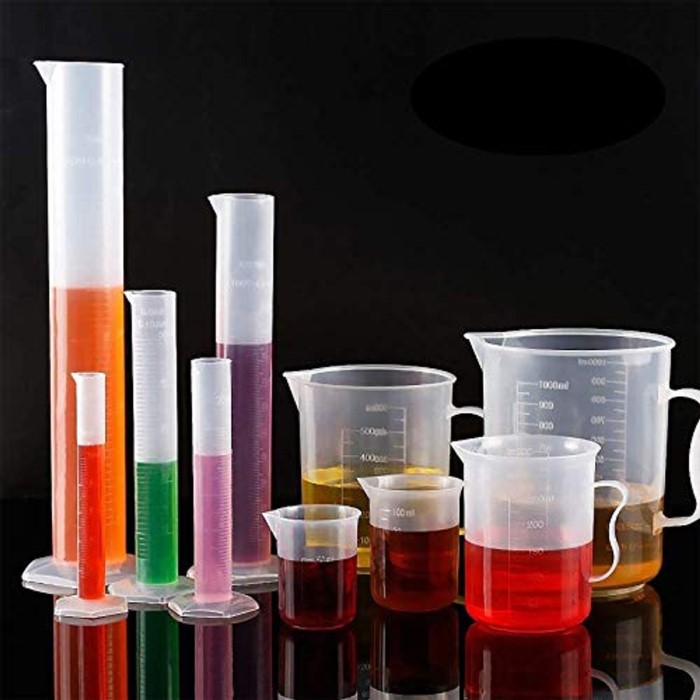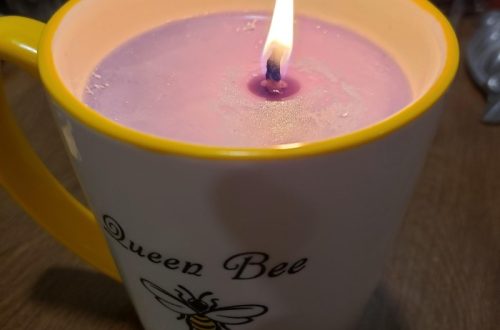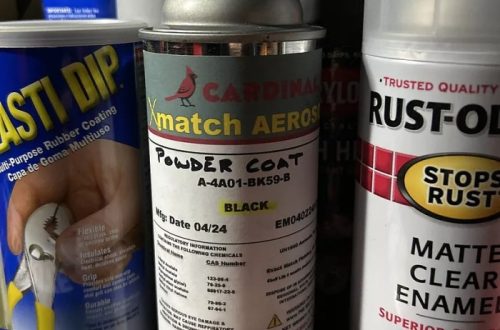Introduction
Laboratory glassware is essential for scientific experiments and measurements. These tools are designed for precision and safety. Beaker vs graduated cylinder is common example of laboratory glassware.
Beakers are versatile containers for mixing or heating substances. Their wide shape makes them easy to use. Graduated cylinders, however, excel in measuring liquid volumes accurately. Both serve unique purposes in scientific activities.
Different types of glassware suit different tasks. Choosing the right tool ensures reliable results in experiments. By understanding each item’s features, scientists can optimize their workflows.
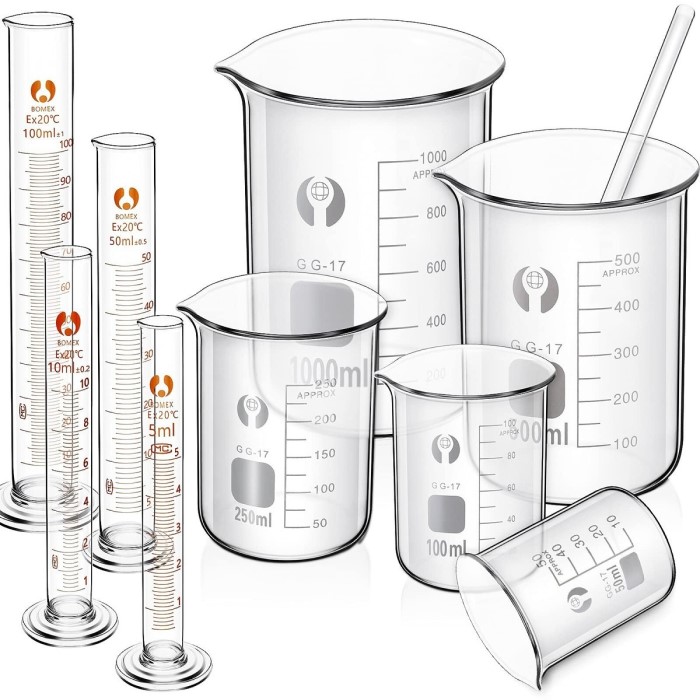
What is a Beaker?
A beaker is a cylindrical container commonly used in labs. It has a flat bottom and a simple spout for pouring liquids easily. Beakers are versatile tools in scientific settings and come in various sizes. They are not specialized for precise measurements but are perfect for general-purpose tasks.
Common Uses of Beakers in Laboratory Settings
- Mixing Solutions: Beakers are ideal for mixing chemicals or solutions.
- Heating Liquids: Their heat-resistant material makes them perfect for boiling or heating substances.
- Transferring Liquids: Use them to pour liquids into other containers or apparatus easily.
- Holding Samples: Beakers can temporarily store liquids, solids, or experimental samples.
Beakers are designed for convenience in procedures and are often found in schools, research labs, and industrial setups.
Design Features of Beakers
- Wide Opening: The wide mouth allows easy access for stirring or adding materials.
- Graduated Markings: Markings on the side provide rough volume estimations but are not highly precise.
- Flat Base: This helps the beaker stay stable on flat surfaces.
- Spout for Pouring: The spout ensures liquids can be poured without much spilling.
- Material: Most beakers are made of borosilicate glass, resistant to heat and chemicals.
Beakers prioritize flexibility and durability, making them indispensable tools in laboratories.
What is a Graduated Cylinder?
A graduated cylinder is a tall, narrow container used to measure liquid volumes accurately. It has a stable base, ensuring that it doesn’t tip over easily. Unlike beakers, graduated cylinders are specifically designed for precision in measurements.
Primary Applications of Graduated Cylinders
- Measuring Liquid Volumes: Graduated cylinders provide precise readings of liquid quantities.
- Density Measurements: Essential for calculating the density of liquids by measuring their volume.
- Titrations: Used in experiments where liquids must be measured before mixing with other substances.
- Liquid Transfers: Helpful when transferring a specific volume of liquid to another container.
Graduated cylinders are critical for experiments that require accuracy. They are often used in schools, research labs, and medical laboratories.
Design Features of Graduated Cylinders
Tall, Narrow Design:
The cylindrical shape is specifically engineered to minimize meniscus-related errors that can occur when taking measurements.
This design allows for a clearer view of the liquid’s surface, improving the overall precision of the measurements taken.
Graduated Markings:
The surface of the graduated cylinder features finely etched lines that serve as reference points for measurement.
These markings are carefully calibrated to provide exact measurement readings, ensuring that users can accurately determine the volume of liquids.
Wide Base:
The cylinder is constructed with a wide base, which enhances stability during use.
This design feature significantly reduces the risk of the cylinder tipping over, making it safer and more reliable for laboratory environments.
Meniscus Guide:
The graduated markings take into account the presence of the meniscus, which is the curved surface of the liquid in the cylinder.
By understanding the meniscus phenomenon, users can achieve more accurate analyses and avoid common measurement mistakes associated with the curvature of the liquid’s surface.
Key Differences Between Beakers and Graduated Cylinders
Understanding the key differences between beaker vs graduated cylinder is essential for laboratory work. These differences go beyond their appearance and influence their usage in experiments.
Accuracy and Precision
- Graduated Cylinders: These are more precise for measuring liquid volumes. Their tall design reduces meniscus reading errors.
- Beakers: Beakers offer rough volume estimations. They are not ideal for accurate measurements.
- Measurement Units: Graduated cylinders feature detailed markings, while beakers provide basic graduations.
Graduated cylinders are perfect for tasks needing precise measurements, such as chemical analysis or titrations.
Measurement Capabilities
- Graduated Cylinders: They excel in measuring liquid volumes, even down to small quantities.
- Beakers: Beakers are better for general tasks like mixing or heating liquids.
- Volume Range: Graduated cylinders come in various capacities for different precision levels. Beakers typically measure larger, less precise volumes.
Use graduated cylinders when exact readings are critical. Beakers fit general-purpose requirements.
Durability and Material
- Graduated Cylinders: Often made of glass or plastic for transparency and chemical resistance.
- Beakers: Typically constructed from borosilicate glass, making them heat-resistant and durable.
- Structure: Graduated cylinders have a narrow design and stable base; beakers feature wide mouths and flat bottoms.
Both tools are chemical-resistant but serve different durability needs. Choose based on your experiment type.
In summary, graduated cylinders specialize in precision, while beakers support versatility in lab tasks. Selecting the right tool will depend on your measurement and experimental requirements.
Pros and Cons of Using Beakers
Beakers are versatile tools in laboratories, offering a wide range of uses and benefits. However, they also come with certain limitations that should consider when selecting laboratory glassware.
Pros of Using Beakers
- Versatility: Beakers excel in general tasks like mixing, heating, and storing liquids or samples.
- Ease of Use: Their wide mouths allow for easy pouring, stirring, and adding substances.
- Durability: Made of heat-resistant borosilicate glass, beakers can withstand high temperatures safely.
- Cost-Effective: Beakers are reasonably priced, making them accessible for educational and professional labs.
- Variety of Sizes: Available in multiple volumes to suit different experimental needs.
Cons of Using Beakers
- Limited Precision: Beakers are not designed for precise measurements, offering only rough volume estimates.
- Spillage Risk: Liquids can spill easily when pouring due to the broader spout.
- Meniscus Errors: Measuring liquid volume can be inaccurate due to the curved liquid surface.
While beakers are reliable for basic tasks, they are not suited for experiments requiring exact measurements.
Pros and Cons of Using Graduated Cylinders
Graduated cylinders offer exceptional accuracy and precision in laboratory settings. While they excel in measurements, they also come with certain drawbacks. Understanding their pros and cons can help in choosing the right equipment for specific needs.
Pros of Using Graduated Cylinders
High Precision:
Graduated cylinders are specifically engineered to deliver accurate liquid measurements.
Their design features minimize the potential for meniscus errors, which can occur when reading the liquid level inaccurately due to curvature effects.
Durable Materials:
These cylinders are typically constructed from high-quality glass or resilient plastic.
The materials used are resistant to a variety of chemicals, ensuring their longevity and ability to withstand various laboratory conditions.
Their transparent nature allows for clear visibility of the liquid inside, facilitating straightforward and accurate readings.
Stable Base:
A graduated cylinder is equipped with a wide and sturdy base, which enhances its stability during experiments.
This design feature is essential for preventing tipping, ensuring that the measurements are accurate and minimizing the risk of spills.
Markings for Accuracy:
The graduated markings on the side of the cylinder are carefully detailed to support precise measurements.
These markings allow users to take accurate readings, even when dealing with small volumes of liquid, which is critical in many scientific experiments.
Variety of Sizes:
Graduated cylinders are offered in an array of sizes, accommodating varying liquid capacities.
This diversity ensures that they can meet the specific needs of different experiments and applications, making them versatile tools in the laboratory.
Compact Design:
The narrow structural design of graduated cylinders is space-efficient, allowing for easy storage and use in limited laboratory spaces.
Their compact form also facilitates handling, especially in crowded environments where laboratory space is at a premium.
Cons of Using Graduated Cylinders
Limited Versatility:
Graduated cylinders are specifically designed for measuring liquid volumes, which makes them less suitable for other tasks.
Unlike beakers or flasks, they are not ideal for mixing substances since their narrow shape limits stirring capabilities.
They are also not appropriate for heating liquids, as their design does not support uniform heat distribution.
Restricted Capacity:
Graduated cylinders come in various sizes, but they typically do not accommodate as large a volume of liquid as beakers or buckets.
For experiments requiring the handling of larger quantities, beakers are often preferred due to their wider opening and greater capacity.
This limitation makes graduated cylinders less efficient when a large amount of liquid needs to be measured in one go.
Fragility:
Many graduated cylinders are made from glass, which is prone to breakage if dropped or mishandled.
Even minor accidents in a busy laboratory setting can lead to broken cylinders, posing safety hazards and causing loss of materials.
Careful handling and storage are essential to prevent damage, making them less user-friendly in high-traffic environments.
Higher Cost:
Compared to general-purpose glassware like beakers, graduated cylinders tend to be more expensive due to their precise manufacturing and calibration.
This increased cost can be a consideration for labs or educational institutions with budget constraints.
Investing in graduated cylinders may not be justifiable if the specific measurement capabilities are not needed.
Time-Consuming:
The accuracy provided by graduated cylinders often requires a more deliberate and careful measuring process.
When dealing with small volumes, users may need to take extra time to ensure they read the measurement correctly without parallax errors.
This attention to detail, while necessary for precision, can slow down overall workflow during experiments or demonstrations.
Graduated cylinders excel in precision but may not suit all experimental needs. Their advantages outweigh disadvantages in tasks requiring accurate measurements.
Choosing Between a Beaker and a Graduated Cylinder
Selecting the right laboratory glassware depends on your experiment’s specific requirements. Beaker vs graduated cylinder has unique strengths that suit different tasks. Understanding these differences will help you make the best choice.
Beakers are ideal for tasks that require versatility. They are perfect for mixing, heating, and storing substances. Their wide openings make them easy to use but limit their measurement accuracy. On the other hand, graduated cylinders excel in precision. They are specifically designed for accurate liquid measurements.
Factors to Consider for Accurate Measurements
When deciding between a beaker vs graduated cylinder, consider these key factors:
- Purpose of Use
- Use a beaker for general tasks like mixing, boiling, or rough volume estimates.
- Choose a graduated cylinder for accurate volume measurements or experiments needing high precision.
- Required Accuracy
- For precise readings, a graduated cylinder is the better choice.
- Beakers provide rough measurements and are not ideal for sensitive data.
- Experiment Complexity
- For straightforward activities, beakers are easier to handle.
- For detailed work, graduated cylinders ensure reliable results.
- Volume of Liquid
- Use beakers for larger volumes with less accuracy.
- Opt for graduated cylinders for smaller volumes needing exact values.
- Durability Needs
- Beakers, made from borosilicate glass, are durable and heat-resistant.
- Graduated cylinders are stable but may be fragile if made of glass.
Making the right choice ensures efficiency and accuracy in your experiments. Select the tool that aligns with your specific needs for optimal results.
Conclusion and Practical Applications
Choosing between a beaker vs graduated cylinder depends on your experiment’s requirements. Beakers are versatile but offer limited precision. Graduated cylinders excel in accuracy but lack versatility for other tasks. Understanding their features ensures proper selection.
Practical Applications of Beakers
- Use beakers for heating, mixing, and storing liquids in general lab tasks.
- They are suitable for experiments requiring quick but rough volume estimations.
- Their durability makes them ideal for high-temperature applications.
Practical Applications of Graduated Cylinders
- Use graduated cylinders for tasks demanding accurate volume measurements.
- They are essential for titrations and density calculations in chemistry labs.
- Graduated cylinders are critical for small-scale quantitative experiments.
By selecting the right tool, you ensure accuracy, efficiency, and safety. Beakers and graduated cylinders both serve vital roles, reinforcing their importance in laboratories worldwide.
Conclusion: Mastering Laboratory Measurement Tools
In conclusion, understanding the differences between a beaker vs graduated cylinder is vital for students engaging in scientific experiments. Each tool serves its own purpose, with beakers being versatile and ideal for mixing, while graduated cylinders offer the precision needed for accurate measurements. By mastering these tools, students can enhance their laboratory skills and ensure successful experiments.
Educators and students alike need to recognize which instrument to use based on the experiment’s requirements. This knowledge not only enriches the learning experience but prepares students for more advanced scientific work in the future.
